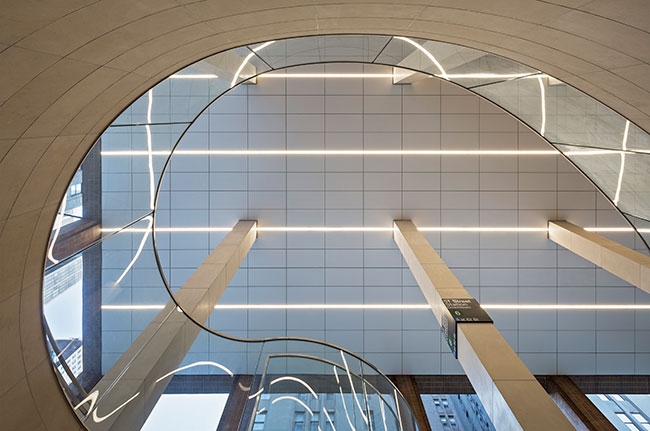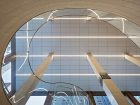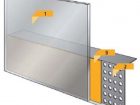
Features
Fabrication
Innovations
Better balustrades – polyurethane grouts open up new possibilities
Polyurethane grouts can create new possibilities.
May 30, 2018 By Marc-Olivier Brosseau and Paul Chackery
 New grouts can make new designs possible by allowing glass to be embedded in the substrate without visible mechanical fastenings. In this subway station, the glass comes straight out of the floor, creating a seamless view.
New grouts can make new designs possible by allowing glass to be embedded in the substrate without visible mechanical fastenings. In this subway station, the glass comes straight out of the floor, creating a seamless view. Light-flooded spaces and a general airiness in buildings are no longer just a trend in the architectural world, but are increasingly state-of-the-art. This general airiness achieved through the use of transparent materials does not end with the balcony. Total vision glazing and glass balustrades can offer continuity to wide open spaces, if they are not interrupted by framing or other mechanical fixations. When it comes to connecting glass to frame materials, new solutions are coming to market every day.
For total vision glazing and glass balustrades, the attachment of the glass panes to the floor ideally is concealed, leaving a barely visible, uninterrupted wall of glass. Glass grouting with cementitious grout has become a widespread, economic technology for balcony glazing, but many cases of breakage have been reported because of its hardness and rigidity.
Furthermore, in the past few years, glazing regulations for balustrades have changed significantly. The 2018 version of the international building code is now out. Codes require that a top rail or handrail be attached to guards with structural glass panels, unless the baluster panels are laminated with two or more glass plies of equal thickness and of the same flat glass type. Furthermore the panels shall be tested to remain in place as a barrier following impact or glass breakage in accordance with ASTM E2353. Similarly CSA A500 is increasing the requirements on the glass thickness and strength. The end result is use of laminated glass and other thick configurations. In all three conditions noted in CSA A500, standard laminated glass is being specified.
Laminated safety glass has replaced single monolithic glass with significant consequences for glass grouting. Cementitious grout is very aggressive against the interlayers for laminated glass, causing discolouration and milky areas and even delamination and glass breakage. It is no longer a durable solution for glass grouting. This has created a need that structural sealant providers have met by developing a compatible solution with self-levelling two-part polyurethane (PU) grouts.
Glass embedding
For example, with the SikaGlaze GG-735 system, the bottom glass edge is embedded in a U-shaped profile. The loads are securely transferred through the glass elements, resulting in uniform stress distribution. The grout creates a strong but flexible fastening solution, capable of withstanding high static and impact loads. It is ideal for glass-wall grouting jobs.
The mechanics and workability of self-levelling two-part PU grouts can be excellent. The better ones offer just enough flexibility to take up some stress created by impact or thermal expansion while remaining rigid enough to prevent sway in the balustrade.
Before specifying a self-levelling two-part PU grout, ensure the product has been rigorously tested for your application. SikaGlaze GG-735 was tested and certified at the Laboratory for Steel and Light Metal Construction in Munich, Germany, for accident proofing, based on technical regulations for the use of accident-proof glazing. Products tested this way are supported by a German general building authority test report. The test comprised two 10-millimeter tempered or heat-strengthened safety-glass panes with a 1.52 millimeter PVB interlayer. The clamping depth of the glass pane was 100 millimeters. The U-channel was made of 10 millimeter steel and was very rigid in order to test the worst-case scenario. Impact tests were carried out with a pendulum, according to DIN EN 12600, with a dropping height of 700 millimeters. Further testing to the Florida building code allows systems of this kind to be compliant as a GMP-Postless Glass Railing System, which requires systems to pass windload tests, concentrated pull tests of 292 pounds with a safety factor of two, and large missile impact tests.
The installation of the glass panes in two-part PU grout systems is simple and economical. They are easily mixed on-site with a butterfly mixer or a two-component pump with a static mixer attached to the nozzle. The long open time of the product offers the applicator two methods of installation. In the first method, the PU grout is filled to a calculated level into the channel. Then the glass glides into its final position. A spacer tape at the bottom and at the edge of the glass maintains the distance between the glass and the support frame. In the second method, glass is first positioned and fixed in the channel, ideally with wedges and setting blocks made of the PU grout for an optimal stress distribution. Then the PU grout is poured into the channel. When employing this method, make sure you select a product with low viscosity. With the second method, a clearance of 10 millimeters between glass and channel is recommended, resulting in a grout volume of only 2.5 liters per meter. With the first method, this volume can be further reduced, but the clearance on each side should not be less than six millimeters. This low volume, together with easy applicability, makes the method a very competitive glass fixation technology, overall. In exterior applications, the PU grout is normally protected against UV radiation and weathering with a bead of silicone sealant.
In the case of glass breakage, the panes can easily be replaced for repair work. The broken glass is first removed. After the glass pane is demolished with a hammer, the lamination interlayer is cut through with a knife. The embedding material and the glass is destroyed with a demolition hammer and lifted out with a crowbar. Finally, the support frame is cleaned thoroughly to remove dust, glass debris and embedding material. Alternatively, the use of a release agent on the channel and the glass before applying the grout makes it possible to remove the un-demolished glass with the help of a crane.
Optimal Optical Appearance
Other new solutions are emerging to improve the balustrade system even further. What if the architect wants to showcase the immaculate optical appearance of the glass and hide the floor slab? Products like Sikasil SG-500 for structural glass bonding can help. A perforated metal sheet, made of aluminum or steel, is bonded to the glass pane. The perforation in the metal profile allows the adhesive to through-cure whatever size bonding area is required. The glass pane may optionally have a screen print on the bonding area to hide the adhesive, as well as the metal profile. Sika also tested this innovative technology at the Laboratory for Steel and Light Metal Construction and at Bucharest University for accident proofing, based on German technical regulations for the use of accident-proof glazing.
In this era of great concern over the safety of balustrades combined with an esthetic desire for unimpeded views, PU grout suppliers are stepping up with new solutions that can satisfy every requirement.
Print this page


Leave a Reply